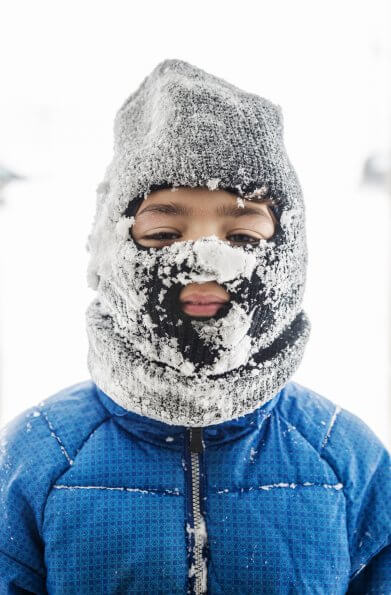
4 practical tips to keep kids warm and safe during winter play
It seems like I’d just put all the mitts and hats away for the summer, but it wasn’t even autumn before I was unpacking them all again to use on our early-morning walk to school.
Brrrrrrrrrr.
I wish we could keep the sun-soaked days of summer year-round, but I know from 40-something years of experience that the cold, snow, and bone-chilling wind are all coming.
This year (for once!) I’m ready.
The shovels are hanging out by the front door. I’ve got my winter tires on. We’ve found our sleds. The kids even have their own coveted snow brushes to help clear off the car!
So c’mon winter. Bring it on.
Despite the sometimes harsh winter weather in Montreal, where I live, my kids and I all enjoy being outdoors and staying active. Sledding, ice skating, and winter hikes are some of our go-to activities. Playing outside in winter is also a great way to stay healthy both physically and mentally.
But when the temperatures drop, staying comfortable and safe outdoors can become challenging, especially for young children and infants.
Because everyone should get outside and play this winter, here are some practical ways to make sure you and your kids can play safely and comfortably in the snow.
1. Dress for the weather
Kalen Hutson and her family live on a farm in rural Manitoba, where the winter temperature can drop to -35C, with the wind making it feel like -45C or -50C.
Between waiting for the school bus (that only stops running when it’s below -45C with the windchill) and activities like outdoor skating and ice-fishing, her kids have learned to dress for the weather.
“The biggest thing is to keep their faces covered, and hands and feet warm,” says Hutson.
“They usually wear balaclavas [see right] with only their eyes showing as well as a neck warmer. We also use warming packs stuffed into mitts and boots if we are going to be outside for a long time when it’s -30.”
2. Keep time outside short in extreme weather
Limit your time outdoors in extreme cold, wet, or windy weather. Pay attention to weather forecasts and wind-chill readings.
In very cold and windy weather, exposed skin can develop frostbite in a matter of minutes. Environment Canada warns that the risk of frostbite increases rapidly when wind chill goes below -27C. On its website, the agency offers advice on how to dress and stay safe when wind chill is a factor. Infants should only be outside in the extreme cold for a few minutes at a time, and toddlers should take frequent breaks.
3. Watch for signs of frostbite
In extreme conditions, and after prolonged periods of time outdoors, parents need to watch their little ones for signs of windburn, frostnip, and frostbite [PDF].
Windburn occurs when cold wind removes the top layer of oil from the skin, causing excessive dryness, redness, soreness, and itching.
As much as you’re tempted to, don’t scratch or rub the affected area as it can damage the skin. Apply a protective skincare product to the affected area and use a protective lip balm to treat lips.
Frostnip (mild frostbite) most commonly affects body parts furthest from the heart like hands and feet, as well as noses, ears, cheeks, and chin.
Frostnip can make skin look yellowish or white, and the tissue is still soft. It can usually be treated at home by warming the area gradually using body heat (an armpit) or warm water. Avoid direct heat, which can burn the skin. If in doubt, call your child’s healthcare provider, especially if there are symptoms that don’t get better, or if new symptoms appear.
Frostbite is the more serious version of frostnip, where skin and underlying tissues freeze and skin feels hard to the touch. Frostbite can be very serious and result in permanent injury and needs to be treated as soon as possible.
Early signs of frostbite include skin colour changes, a tingling sensation, numbness, or swelling. On your outdoor adventures, bring along warm snacks, soup, or hot chocolate. Check toes, fingers, noses, and ears often for signs of frostbite.
To treat frostbite, the Canadian Paediatric Society recommends you:
- Gently remove any clothing covering the area
- Put your child in dry, warm clothing
- Slowly warm up the area by gently covering it with your hand
- Use warm (not hot) water to slowly warm affected body parts
- If your child’s fingers are frostbitten, place them in his/her opposite armpit to warm
- Do not massage or rub snow on frostbitten skin
- Seek medical advice immediately if your child’s skin is white, waxy or feels numb
4. Keep moving
Physical activity will increase metabolism and body heat, and keep everyone warm. Check out Active for Life’s outdoor activity bucket list that will inspire you to get moving and keep active all winter long!

All photos except balaclava image courtesy of Christine Latreille.
Check out these other tips:
How to dress for the weather in every season
How to dress your baby for spending time outdoors in the winter






